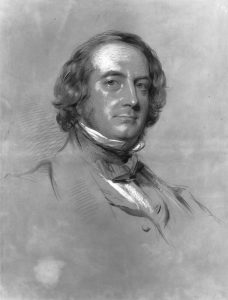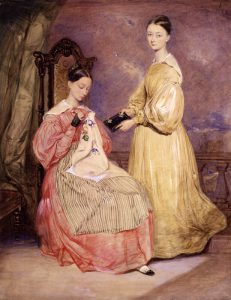
October 25, 2018, by Richard Bates
The Suitor and the Sister
Richard Monckton Milnes (1809-1885), a poet and politician, was the person that Florence Nightingale came closest to marrying. Her decision to reject him in 1849 led to a prolonged period of soul-searching, one that continued during a voyage to Egypt and Greece in 1850, and only began to be resolved when, on the way back, she visited the nursing institution at Kaiserswirth, Germany.
This letter, to his sister Henrietta Eliza Monckton-Arundell, Viscountess Galway, was written in 1846, at a relatively early stage in his relationship with Nightingale. It is just one of over 200 letters sent from Richard Monckton Milnes to his sister now held among the papers of the 6th Viscountess Galway at the Manuscripts and Special Collections department of the University of Nottingham. (The Viscountess’ papers form part of ‘The Papers of the Monckton-Arundell Family, Viscounts Galway of Serlby Hall, Nottinghamshire, early 13th century-1958’, collection reference Ga, which were deposited at Manuscripts and Special Collections by the family).

Letter by Richard Monckton Milnes to Viscountess Galway, 1846. UoN MSC ref Ga 2 D 1019/1-2, used with permission.
At the time the letter was written, Florence Nightingale was 26 years old, and still some years away from her famous Crimean War experiences. It comes from a period in which Nightingale, forbidden by her family in 1845 from taking up a nursing position, was feeling constrained and oppressed by social convention, and unable to see how she would find an outlet for her professional energies and desire to make a difference in the world. An alliance with Monckton Milnes tempted her, yet she would ultimately feel unable to accept it, fearful that she would be merely exchanging the confinement of the parental home for that of a marital one.#
In the letter, Milnes offers some impressions of Nightingale for his family’s benefit, and mulls over her suitability as a marriage partner. Richard’s father, the landowner Robert Pemberton Milnes, had been pressuring him to marry. Milnes senior was from that part of the upper classes which valued status and breeding over money. The Nightingale family possessed a fortune: they owned an 80-bedroom house in Hampshire and a second country home in Derbyshire. But their money had come from the lead mining operations of Florence’s great-uncle Peter Nightingale in Derbyshire; the Nightingales could not lay claim to centuries of noble heritage. Though the Milnes money ultimately came from industry too – Robert Pemberton Milnes’ grandfather had been a cloth merchant – Milnes senior felt that his place was among the landed aristocracy.

‘Richard Monckton Milnes, 1st Baron Houghton’, chalk drawing by George Richmond, c. 1844. National Portrait Gallery, Creative Commons CC BY-NC-ND 3.0.
‘I fancy Papa looks on the Nightingales as rather vulgar people’, Richard told his sister. Thus, ‘he may look on [a marriage alliance] as rather a descent in society than an elevation … they are also all monied people to whom he would dislike exploring his pecuniary embarrassments and who, he thinks, would not sympathise with him as other mortgage landlords would.’
Nonetheless, Milnes added hopefully, perhaps his father ‘would be much happier with a daughter-in-law perhaps a little below our rank of society than with one higher, before whom he would have to be pretending to be something other than he is.’
Milnes here appears to be trying to persuade himself, as much anyone else, that a marriage to Nightingale could work. A marriage to someone of a different caste presented problems, but perhaps Florence’s unusual qualities would allow them to be overcome:
‘F.N. is certainly a very remarkable person, with a gravity of deportment which I can conceive many people disliking and a clear observant critical way of looking at things, which many might dislike, but which I find very analogous to my own. She is a companion worthy of any man of intellect […]’
Milnes clearly admired Nightingale, but there is also certain ambivalence here, an awareness that Nightingale’s intellectual seriousness would not be to everyone’s taste. Nevertheless he wrote that Nightingale ‘is exactly the person whom my father would soon entertain a great respect for’.
Florence wasn’t the only eligible Nightingale daughter that Milnes had met on visiting her home. There was also her older sister, Parthenope (later Frances Parthenope Verney). But Milnes’ view of Parthenope wasn’t quite as flattering:
‘[M]y feeling as to the two is very much that I am conscious of condescending to the one and of looking up to the other, which is true physically as well as morally.’ Whereas Florence was someone that his father would greatly respect, ‘I cannot say [this] of the other’
In effect, Parthenope was shorter than Florence, and generally regarded as less intellectually outstanding and physically attractive. She didn’t seem to have her sister’s determination and strength of will. To Monckton Milnes she, unlike Florence, was not a serious marriage prospect.
William White’s Painting
Milnes’ comparison throws an interesting light on the painting of the two sisters by William White, dating from the 1830s, which hangs in the National Portrait Gallery. In that painting, Parthenope stands with her face full to the viewer, and holding a book. Florence sits beside her, sewing, with her head turned to the side.
The painting, in other words, appears designed to negate the kinds of contrast between the sisters drawn by Monckton Milnes. In this representation, Parthenope stands above Florence. By holding a book, she lays claim to an intellectual capacity. Florence meanwhile, who would fight so hard to escape the conventional expectations of a woman of her time, appears as a seamstress. Perhaps the painting was an attempt by the sisters – or more likely, their parents – to respond to and shape the way that others were perceiving them.

‘Florence Nightingale and Frances Parthenope, Lady Verney’, watercolour painting by William White, c. 1836. National Portrait Gallery, Creative Commons CC BY-NC-ND 3.0.
In that sense, perhaps Milnes’ letter has something in common with the painting. Gillian Gill argues in her book Nightingales (2004) that Monckton Milnes was very possibly homosexual or bisexual, and if so his pursuit of a wife could well have been partly an exercise in providing social cover. The Oxford Dictionary of National Biography considers this unproven, but Milnes undeniably had a strong interest in sado-masochistic pornography, and was one of the first collectors of the works of the Marquis de Sade. This only became known to his family and the public after his death. In 1851 he married Annabel Crewe, from a Yorkshire gentry family. Annabel dutifully wrote a letter to her father in law every day. The couple had three children; one of them was named … Florence.
Nightingale was almost certainly correct to refuse Milnes; the risk that marriage would threaten her vision of her mission in life was too great. Nightingale, unlike Milnes, had no interest in playing the society host, and would not have responded well to the programme of twenty-six society dinners and twelve breakfast parties that Milnes asked Annabel to lay on in her first season as a hostess. In her diary (now lost, but quoted in Cook’s 1913 biography) Nightingale wrote:
‘I have an intellectual nature which requires satisfaction, and that would find it in him. I have a passional nature which requires satisfaction, and that would find it in him. I have a moral, an active nature which requires satisfaction, and that would not find it in his life … I could be satisfied to spend a life with him combining our different powers in some great object. I could not satisfy this nature by spending a life with him in making society and arranging domestic things … To be nailed to a continuation and exaggeration of my present life, without hope of another, would be intolerable to me.’
— This piece also appears in the September 2018 edition of the UoN Manuscripts and Special Collections newsletter. Richard would like to thank senior archivist Hayley Cotterill for assistance with the research. —
— For more information on our project please also visit our website at www.florencenightingale.org —
References:
- Mark Bostridge, Florence Nightingale, The Woman and Her Legend (London, 2008), esp. pp.126-9.
- Edward Cook, The Life of Florence Nightingale (London, 1913), vol I., p.100.
- Gillian Gill, Nightingales: The Story of Florence Nightingale and Her Remarkable Family (London, 2004), pp. 157; 220-32.
No comments yet, fill out a comment to be the first

Leave a Reply